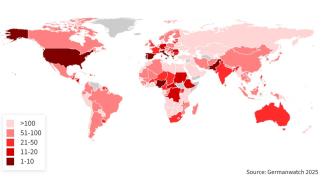Global warming
Climate change in numbers

1.55 °C
was the amount by which the global average temperature exceeded pre-industrial levels in 2024. It is very likely therefore that 2024 was the first year in which the 1.5 °C target laid down in the Paris Agreement was surpassed. The El Niño phenomenon also played its part in this, alongside the ongoing rise in greenhouse gases.1
The last 10 years
have all been amongst the 10 hottest on record,
making for an unusual series of temperature records.1
Roughly 90 %
of the excess heat caused by global warming is stored
in the oceans, meaning that sea temperatures are one
critical indicator of climate change. The rate of warming over the past two decades (2005-2024) was more than twice as high as in the period 1960-2005.1
102 mm
is the extent to which sea levels rose between 1993
and 2025.2 The speed of the increase has more than doubled from 2.1 mm per year (1993-2002) to 4.7 mm
per year (2015-2024).1
74 %
of 750 extreme weather events worldwide were exacerbated or made more probable by climate change, according to studies.3
45.5 million
people were displaced internally in 2024 as a result
of weather-related disasters such as flooding, storms, forest fires and drought. This is nearly twice the average of the last 10 years. By the end of 2024, 9.8 million people were living in internal displacement because of disasters. This includes those forced to leave their homes in recent years who had not been able to return or find any long-term solution by 2024.4
4.2 trillion dollar
is the total inflation-adjusted cost of the damage wreaked by extreme weather events between 1993 and 2022 – roughly equivalent to Germany’s gross domestic product. More than 765,000 people died as a consequence of extreme weather during this period.5
One in eight
deaths globally was attributable to air pollution in 2019. This equates to around 6.7 million fatalities.7
19 %
is the amount by which the world economy risks seeing its income reduced by 2050 versus a scenario without climate change impacts, a study has found out. This would even apply if future emissions were drastically cut or halted. Known as “committed damages”, these are the result of historic emissions. By contrast, damages post-2049 will largely depend on future emissions.6
60 %
is the amount by which income losses in those countries least responsible for climate change will surpass those of countries with high emissions.6
Sources
- World Meteorological Organization, 2025: State of the Global Climate 2024
- National Aeronautics and Space Administration, 2025: Climate Change: Vital Signs of the Planet
- Carbon Brief, 2024: Mapped: How climate change affects extreme weather around the world
- Internal Displacement Monitoring Centre, 2025: 2025 Global Report on Internal Displacement (GRID)
- Germanwatch e. V., 2025: Climate Risk Index 2025
- Kotz, M., Levermann, A., Wenz, L., 2024: The economic commitment of climate change
- World Health Organization, 2024: Sustainable development goal indicator 3.9.1: mortality attributed
to air pollution
Isah Shafiq studiert Politikwissenschaft an der Goethe-Universität Frankfurt und ist Werkstudent bei E+Z.
euz.editor@dandc.eu
This story is part of The 89 Percent Project, an initiative of the global journalism collaboration Covering Climate Now.














